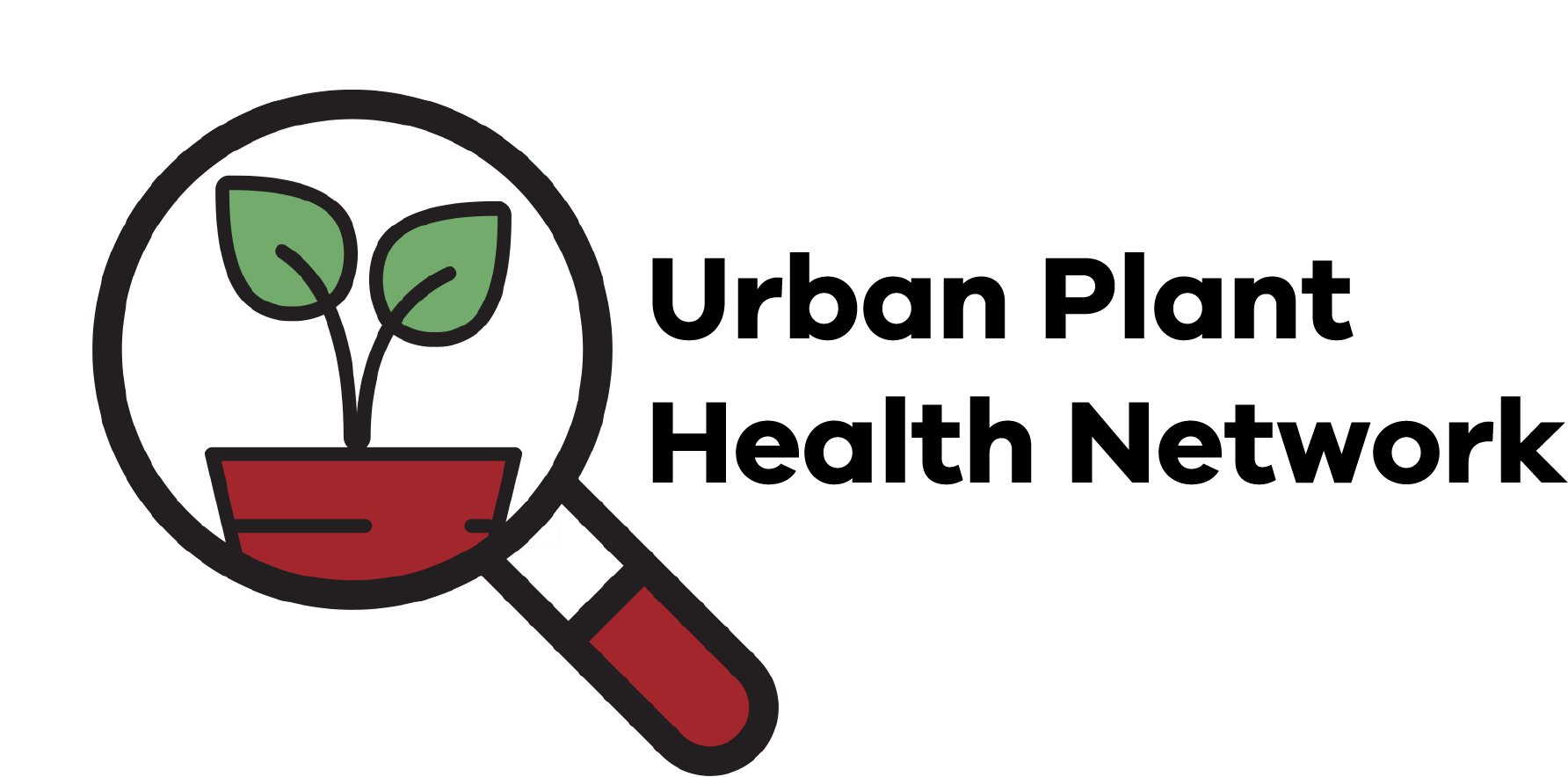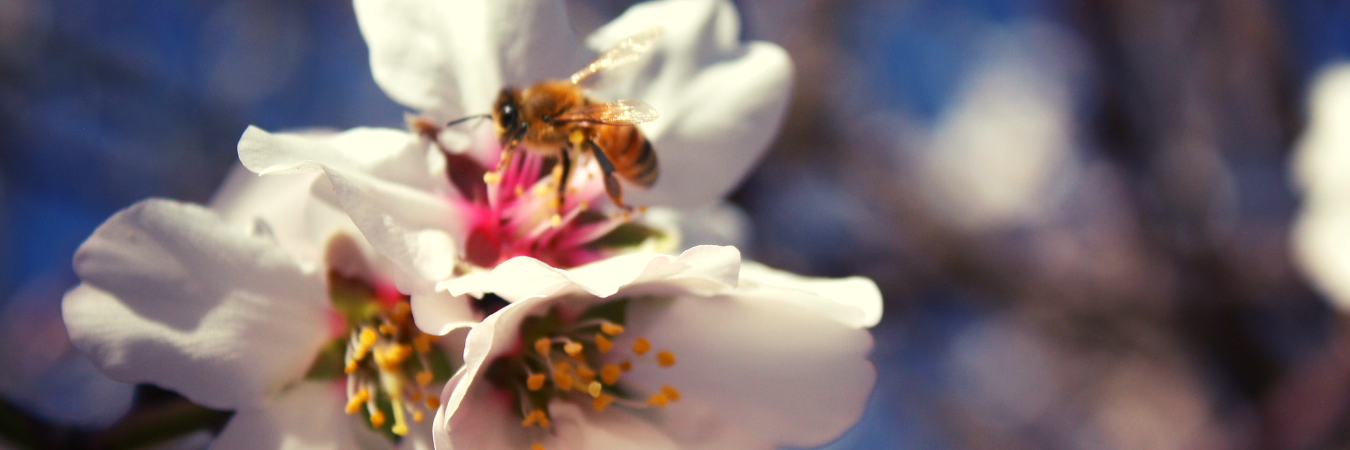With spring upon us, backyard beekeepers should be preparing to conduct inspections and maintenance on their hives.
Beekeepers have an important role to play in protecting their honey bees and the entire honey bee industry from the spread and impact of established pests, as well as the possible entry and establishment of exotic pests.
All backyard beekeepers should be familiar with the Australian Honeybee Industry Biosecurity Code of Practice. Agriculture Victoria’s apiary officers suggest the following checklist for backyard beekeepers to ensure they are supporting bee biosecurity best practice and complying with regulations:
- Must be registered and display their allotted brand on their hives
- Must visually inspect each hive at least twice in every year for established honey bee pests and diseases
- Must inspect one hive in their apiary every year for exotic honeybee pests
- Must report all notifiable diseases to an apiary officer
- Must keep records of biosecurity related actions and observations
Established Honey bee pests
Inspecting your hives regularly for anything unusual is a good way to stay on top of any pests that make it into your hive. There are a number of established pests of honey bees in Australia that have an impact on the strength and productivity of a colony, but we will focus on American Foulbrood in this article.
American Foulbrood (AFB)
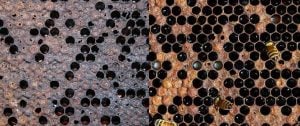
Hives infected with American foulbrood.
Images courtesy of https://beeaware.org.au
American Foulbrood is an infectious, notifiable and incurable disease of honey bees. Infected bee colonies become weak and die. There is no treatment for AFB infected hives. The use of antibiotics including Oxytetracycline hydrochloride (‘OTC’) for AFB is illegal in Victoria and is not an effective treatment. Early detection is important to reduce the risk of spread. Bee colonies and hives infected with AFP need to be destroyed and any infected materials need to be irradiated.
Some symptoms of AFB include: irregular brood pattern, sunken caps of the cells and some caps may be perforated. Infected larvae change colour from a normal white to a light brown or coffee brown. The moist, brown, decaying remains of an infected AFB larva may be ‘roped’ out of the cell with a matchstick to 30mm or so.
If you have, or suspect, AFB in your hive, you must contact an apiary officer (contact details are provided at the bottom of the page). American Foulbrood is a notifiable disease under the Livestock Disease Control Act 1994.
Honey culture testing and larval smears
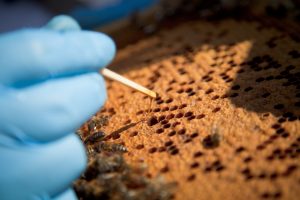
Matchstick honey sample
Beekeepers can have honey tested to detect AFB spores by Gribbles Veterinary Pathology.
Honey culture tests (HCTs) are an effective tool that can detect early infections of AFB. Beekeepers are required to pay for their HCT.
Larval smears of suspect AFB cells can also be submitted to Gribbles Laboratory.
This is done by removing a single diseased or suspect honey bee larva (or remains) from its cell using a clean matchstick and smearing it on a labelled glass slide.
Please contact Gribbles Veterinary Pathology on (03) 9538 6740 or 1300 307 190 or via gribblesvets.com.au for HCT and larval smear test information sample kits and current prices for testing.
Exotic honey bee pests
Along with the established pests such as AFB, it’s also important to be on the lookout for any exotic pests not currently in Australia, but affecting honey bee colonies in other countries.
Varroa mite
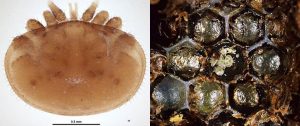
Close-up of Varroa destructor mite and hive infected with V. destructor.
Images courtesy of https://beeaware.org.au/
Varroa mite is a parasite infecting honey bee colonies in every major beekeeping region in the world – except Australia. Early detection of varroa is a key factor influencing our chance of controlling the parasite and reducing its economic and social impact on the whole community.
Based on overseas experience, established varroa cause a shortage of bees for pollination of bee dependant horticultural and seed crops.
Varroa mites (Varroa destructor and V. jacobsoni) are tiny red-brown external parasites of honey bees. Although Varroa mites can feed and live on adult honey bees, they mainly feed and reproduce on larvae and pupae in the developing brood, causing malformation and weakening of honey bees as well as transmitting numerous viruses.
Adult female varroa are reddish-brown, shaped like a scallop shell, about 1.1 mm long and 1.7 mm broad and visible to the naked eye. Females of Varroa jacobsoni, another exotic species, are smaller than females of V. destructor, being about 1.0 mm long and 1.5 mm wide.
Checking your hive for exotic mites needs to be done via one of the following methods:
- sugar shaking,
- alcohol washing or
- drone uncapping and examination.
If you see or suspect varroa is present in your apiary, you must notify Agriculture Victoria on (03) 9217 4166, or alternatively the Exotic Plant Pest Hotline on 1800 084 881.
Notification is required by the Livestock Disease Control Act (1994).
Further Information
General
Beeaware
Plant Health Australia biosecurity online training
Agriculture Victoria – Bees
American Foulbrood
Beeaware – American Foulbrood
Agriculture Victoria – What to do if you detect or suspect American Foulbrood
New South Wales Department of Primary Industries – Pests and diseases of honey bees
Varroa mite
Agriculture Victoria – Varroa mite of honey bees
Beeaware – Varroa mites
Agriculture Victoria Apiary Team
Joe Riordan- Statewide Apiary Specialist
Daniel Martin- Leading Apiary Inspector
Nikki Jones- Apiary Inspector
Ally Driessen- Bee Biosecurity Officer
